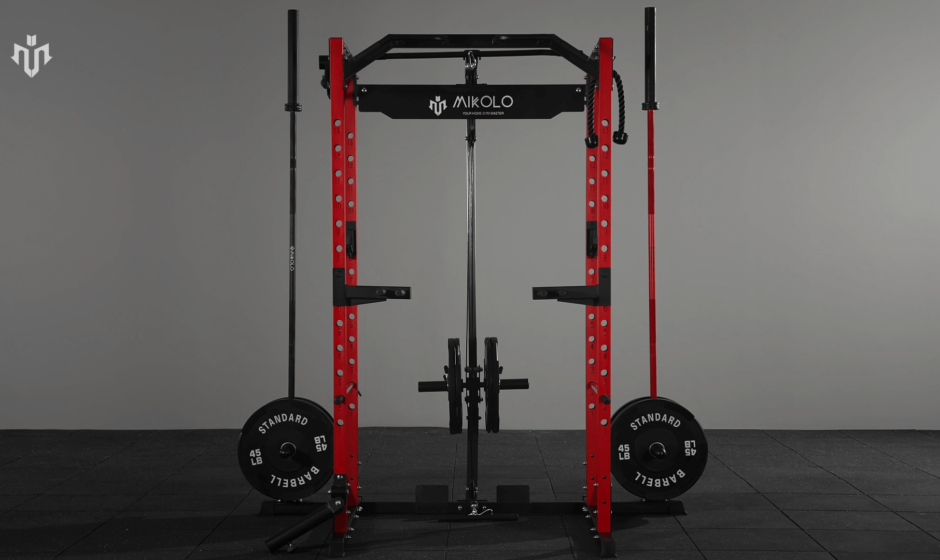When it comes to building strength, gaining muscle, and enhancing your home gym setup, a power rack stands out as one of the most versatile and essential pieces of equipment. Whether you’re a novice lifter looking to build a solid foundation or a seasoned athlete aiming to break through plateaus, a power rack (also known as a squat rack or power cage) offers unmatched safety, stability, and adaptability for a wide variety of exercises. In this comprehensive guide, we’ll explore everything you need to know about MIKOLO home gym power rack, why they are crucial for your fitness journey, and how to choose the best one for your needs.
What is a Power Rack?
A power rack is a robust, four-post metal structure designed to facilitate a broad range of strength training exercises, especially those involving a barbell. It typically features adjustable barbell hooks (also called J-hooks or J-cups) and safety bars or pins that allow lifters to catch the bar if they fail to complete a lift. This is particularly beneficial for exercises like squats, bench presses, and deadlifts, where lifting heavy weights without assistance can be risky.
Some power racks come equipped with additional attachments such as pull-up bars, dip handles, and resistance band pegs, expanding the range of exercises you can perform with one piece of equipment.
Key Benefits of Using a Power Rack
1. Enhanced Safety
One of the primary advantages of a power rack is the increased safety it provides. The adjustable safety pins or straps act as a fail-safe mechanism that catches the barbell if you can’t complete a lift. This allows you to push your limits during exercises like squats, bench presses, and overhead presses without the need for a spotter. Whether you’re training alone or in a home gym, the peace of mind provided by the safety features is invaluable.
2. Versatility in Training
A power rack allows you to perform a wide range of exercises with just one piece of equipment. While it’s best known for barbell exercises like squats and bench presses, its versatility extends far beyond these basics. Many power racks come with attachments that enable you to incorporate bodyweight exercises like pull-ups and dips into your routine. Additionally, resistance bands and chains can be added to introduce variable resistance training, further increasing the versatility of the rack.
3. Supports Progressive Overload
Progressive overload, the process of gradually increasing the weight you lift over time, is critical for strength gains. A power rack enables you to lift heavier weights safely, allowing you to continually challenge yourself and build strength. Without the fear of injury, you can focus on proper form and pushing yourself to new heights in your training.
4. Customizable for Different Exercises
Most power racks are highly customizable. The barbell hooks and safety pins are adjustable, allowing you to modify the height based on the exercise and your body dimensions. Whether you’re performing bench presses, squats, or shoulder presses, you can set the rack up to meet your specific needs. Some racks also feature accessory compatibility, such as lat pulldown attachments or cable crossovers, making it an all-in-one gym solution.
5. Ideal for Home Gyms
For those building a home gym, a power rack is a must-have piece of equipment. It consolidates multiple functions into a single, space-efficient structure. Without the need for multiple machines or a large footprint, you can perform almost any major barbell-based exercise. Plus, with a few additional attachments, you can turn your power rack into a full-body workout station.

Popular Exercises You Can Perform on a Power Rack
The power rack is incredibly versatile, allowing for a broad range of exercises that target every major muscle group.
1. Barbell Squats
Squats are one of the best compound exercises for building lower body strength, targeting the quadriceps, hamstrings, glutes, and core. The power rack makes squatting safer by providing a stable structure and adjustable safety bars in case you need to bail on a lift.
2. Bench Press
With the addition of a bench inside the power rack, you can perform bench presses safely. The adjustable J-hooks hold the barbell at your desired height, and the safety pins catch the weight if you’re unable to complete the lift.
3. Overhead Press
The overhead press is another compound movement that works the shoulders, upper chest, and triceps. The power rack can be adjusted to hold the barbell at shoulder height, allowing you to press the weight overhead safely.
4. Rack Pulls (Partial Deadlifts)
Rack pulls, a variation of the deadlift, focus on the top portion of the lift, helping to strengthen the back and improve lockout strength. The power rack allows you to set the barbell at different heights, so you can target specific portions of the deadlift movement.
5. Pull-ups and Chin-ups
Many power racks come equipped with a pull-up bar, making it easy to integrate bodyweight exercises like pull-ups and chin-ups into your routine. These movements are great for building upper body strength, particularly in the back and arms.
6. Dips
If your power rack includes dip bars, you can perform dips to work your triceps, shoulders, and chest. Dips are a great bodyweight exercise for building upper body strength and muscle mass.
7. Accessory Exercises
Many power racks are compatible with additional accessories such as lat pulldown attachments, cable rows, and resistance band pegs. These additions can further expand the range of exercises you can perform, making the power rack a comprehensive solution for total-body training.
How to Choose the Right Power Rack for Your Home Gym
When choosing a power rack, it’s important to consider a few key factors to ensure it meets your needs and goals.
1. Space Requirements
Before purchasing a power rack, measure the space in your home gym to ensure it fits comfortably. Take into account the height of the rack and whether your ceiling is high enough for overhead lifts or pull-ups.
2. Weight Capacity
Consider the maximum weight capacity of the power rack. If you’re lifting heavy, you’ll want a rack that can support more than your maximum lift to accommodate future strength gains. Look for a rack made from high-quality steel that provides stability under heavy loads.
3. Adjustability
Make sure the rack offers adjustable J-hooks and safety pins to suit a variety of exercises and accommodate different heights. This will allow you to switch between exercises like squats and bench presses without much hassle.
4. Attachments and Accessories
Some power racks come with built-in pull-up bars, dip handles, or weight plate storage pegs. Determine what features are most important to you based on your workout needs. You can also consider racks that are compatible with cable attachments or lat pulldown systems.
5. Budget and Durability
Power racks come in a wide range of prices, from budget-friendly options to high-end models used in professional gyms. While you may be tempted to go for the cheapest option, remember that a power rack is an investment. Look for a well-built, durable rack that offers longevity and safety for years to come.
Conclusion
A power rack is an essential piece of equipment for anyone serious about strength training, whether you’re working out at home or in a commercial gym. Its safety features, versatility, and ability to support progressive overload make it the cornerstone of any effective strength training program. By understanding the benefits of using a power rack and choosing the right one for your needs, you can maximize your workouts, minimize injury risk, and steadily progress toward your fitness goals. Investing in a quality power rack is investing in your strength, performance, and long-term health.
Read also: https://fastpanda.in/



